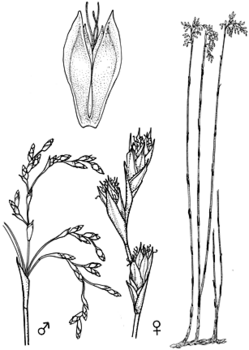Leptocarpus tenax (Labill.) R.Br. APNI* 
Description: Dioecious perennial herb; rhizome shortly creeping, 4–7 mm diam.
Culms erect, straight, mostly unbranched up to the inflorescence, mostly 50–130 cm high, 1–2 mm diam., greyish green with a covering of closely appressed, scale-like trichomes.
Leaves with sheath closely appressed, brown, striate, obtuse or sometimes acuminate; lamina, erect, reduced. Male inflorescence panicle-like, loose, drooping terminal; spikelets numerous, pedicellate, several-flowered, oblong-ovoid, acute, 3–5 mm long, c. 1 mm diam.; glumes dark brown. Male flowers flattened: tepals 6; anthers on very short filaments. Female spikelets simple, either solitary and terminal or several shortly pedicellate, in a terminal raceme or narrow panicle, erect, oblong to cylindrical, becoming turbinate, 10–17 mm long, several-flowered; glumes red-brown. Female flowers flattened: tepals 4; ovary oblong-linear; style branches 3.
Fruit 1–3 mm long, narrow, pale.
Distribution and occurrence: in damp to wet heaths and sedgelands; coastal districts and inland to the Blue Mtns and Torrington.
NSW subdivisions: NC, CC, SC, NT, CT, ST
Other Australian states: Qld Vic. Tas. W.A. S.A.
Text by A. L. Quirico & B. G. Briggs
Taxon concept: Flora of NSW 4 (1993)
APNI* Provides a link to the Australian Plant Name Index (hosted by the Australian National Botanic Gardens) for comprehensive bibliographic data
***The AVH map option provides a detailed interactive Australia wide distribution map drawn from collections held by all major Australian herbaria participating in the Australian Virtual Herbarium project.
|


